Telehandlers: Building up
15 March 2017
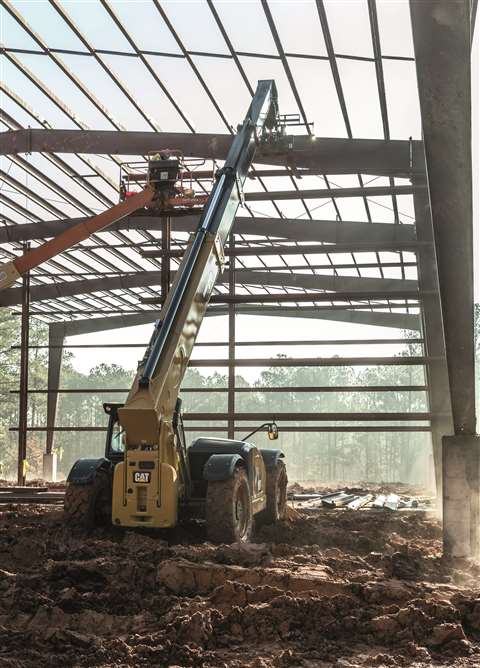
The synergies between access platforms and telehandlers becomes more notable as the likes of JCB, with its broad range of telehandlers, enters the access market this this year, and Skyjack spends much of last year boosting its telehandler fleet, bringing it up to the same level of competitors. Those two companies are just two examples.
Skyjack is presenting its new SJ1256 TH telehandler during ConExpo in Las Vegas, in March. The model brings the TH range, aimed at the North American market, to the 12000 pound lifting capacity market.
In 2016, Skyjack completely reassessed its telehandler design while implementing the Tier IV Final engines, resulting in the TH range which offers simpler rear axle stabilisation, hydraulics systems, outriggers, controls, engine servicing and electronics.
The company is making a serious impact on the telehandler sector, where it has had a small market share in previous times.
The SJ1256 TH has the ability to place 12000 pound loads to 35 ft in height and 7000 pounds to a maximum height of 56 ft. For another new product, the SJ1056 TH, Skyjack aimed to redefine what a 10000 pound class machine is capable of. The SJ1056 TH can take 10000 pounds load to 44 ft – providing increased productivity and versatility over most 12000 pound units, the company says.
Full line
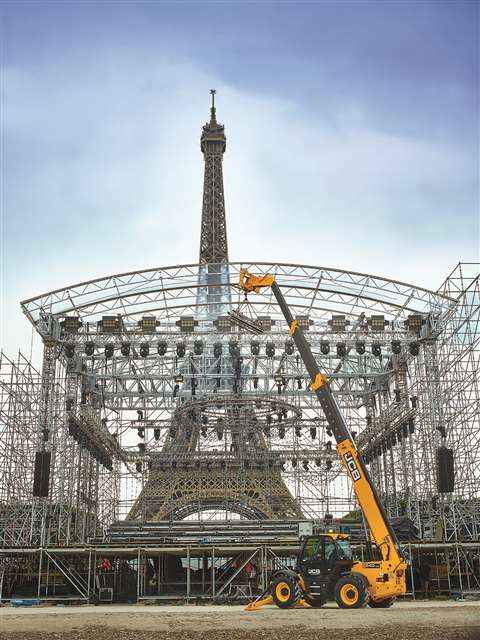
Also, when it comes to Tier IV Final regulations, “Skyjack knew rental rates don’t just go up to meet the increased costs of emissions compliance,” says Barry Greenaway, senior product manager, Skyjack. That’s why the company designed the TH range to require no diesel particulate filter (DPF), while the SJ643 TH up to the SJ1056 TH require no diesel exhaust fluid (DEF) and no other active exhaust after treatment on standard engines for Tier IV Final.
As of this time, the SJ1256 TH is the only unit with a 2017 release date. But Skyjack is now investigating designs for other category classes as part of its commitment to being a full line supplier.
“We believe the trend is towards telehandlers truly designed with the rental marketplace in mind,” comments Mr Greenaway. “The demands of that market typically have variations from the end user market and our interpretation of how best to meet them is with simple, reliable designs that have priorities on uptime, service access and that use affordable, easy to source parts. We also see features, like our FlexCab that can be easily be converted from open to enclosed for example, that assist fleet managers from both small and large rental companies.”
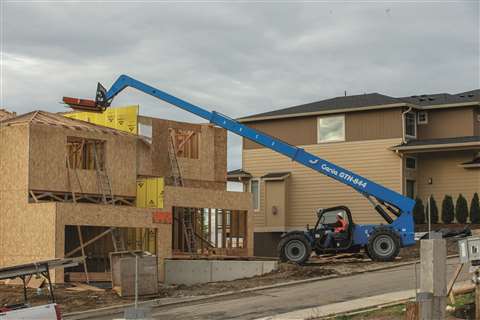
And, as the number of telehandlers on the market becomes ever larger, customers experience increased pressure on rental rates to retain their accounts. “Helping our customers with that success requires more than just a focus on initial acquisition cost; continuous improvement to reduce running costs and increase product flexibility is a constant challenge.”
It won’t have escaped many people’s notice that while Skyjack has been actively making inroads into the telehandler market, JCB –already a major telehandler manufacturer - has entered the access equipment market. Not just with a range of platform options launched in 2016 for its 540-140, 540-170 and 540-200 models, along with the 540-180 launched this year, but with a range of 27 scissors and booms promised throughout this year. (See Manufacturer News in the January/February issue of AI for more details on this).
This year, the company has also been busy launching new telehandler products. The JCB 540-180 is an 18 m lift height, HiViz model which has gone into production this year. The 540-180 HiViz offers greater performance and lifting capability than its 17 m stablemate the 540-170 – despite being 20% smaller in overall dimensions. Its launch brings to 82 the number of Loadall models in the JCB range.
The 540-180 HiViz has been specifically built to meet the needs of rental companies with improved lift height and increased forward reach. At just 2.35m wide and 6.26m long it is possible to move two machines on a single curtain sided truck or low loader, reducing transport costs.
Dual technology
This year has also seen the development of what JCB describes as the world’s first dual technology transmission designed specifically for its Loadall telehandlers. Combining the characteristics of powershift and hydrostatic drives, the Industrial DualTech VT variable transmission includes fully hydrostatic drive, providing fine stepless speed control up to 19km/h, automatic switching to electronically-modulated three-speed powershift above 19km/h, for optimum power efficiency in higher speed work, plus Power and Economy modes to optimise performance, efficiency and running costs. Flexi mode provides independent engine and ground speed control. This innovation has now been introduced with the 531-70 Industrial DualTech VT, 535-95 Industrial DualTech VT and 541-70 Industrial DualTech VT models.
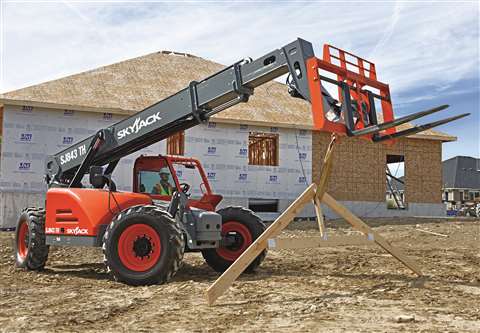
A range of high capacity, industrial telescopic handlers also joined the range in September 2016.
In addition Smart power, which sees JCB Loadalls achieve relevant emissions legislation without the need for exhaust after treatment, is now a feature across the JCB telehandler line-up.
A key requirement from the industry, says the company, and a focus for JCB has been to improve the direct visibility for the operator. This reduces the potential for accidents on site and the potential for site damage to the machines themselves.
However, the company says it did not see substantial growth in 2016. “It has actually declined slightly. JCB expects 2017 to see a return to growth in the EU and North America. The developing markets represent the biggest growth potential for telescopic handlers,” said a company spokesperson.
Oil prices and agricultural commodity prices are likely to be the biggest influences on growth.
Cat is also launching new products. In 2017, the company will introduce further models for construction and rental in the TH D Series. This new series has been developed to improve efficiency, power, and to help make servicing and maintenance easier.
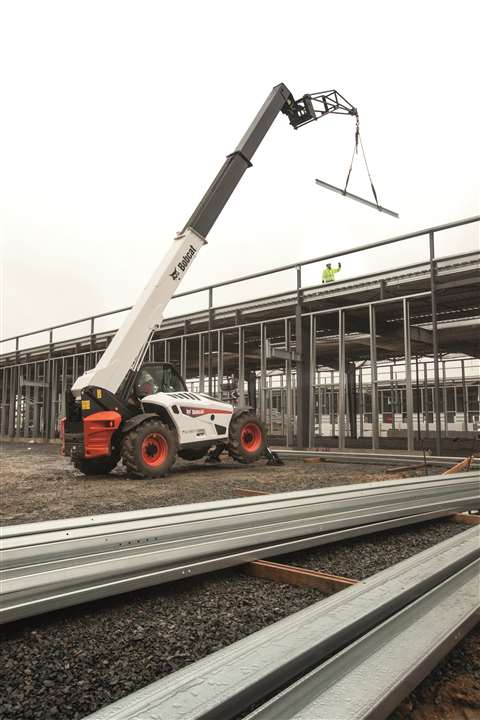
The 4000 kg capacity TH314D and TH417D will replace the current GC Series and are specifically designed for the rental market. The TH514D also replaces the TH514C.
In addition, for North and South America, the TL D Series range was released in 2016, as was the TH3510D, announced in April. It provides 9.8 m lift height and 3500 kg lift capacity, within a compact frame for space restricted sites.
This all adds to Cat’s existing TH C Series, featuring two 14 m telehandlers with 4000 kg and 5000 kg lift capacities, and a 4000 kg capacity, 17 m telehandler for construction markets. In North and South America, the company also offers four high boom models in the TL Series: TL642D, TL943D, TL1055D, and TL1255D.
Matthew Kelly, telehandler marketing specialist for Cat explains, “The main feature are improved cycle times and lift capacity of our machines due to flow sharing technology.” The longitudinally mounted engine allows ground level access to filters and maintenance parts. And new on the D models, is the advanced display monitor that provides information on maintenance schedules, diagnostics, and machine settings. The low boom-pivot point and elevated cab ensure good visibility, while increased safety comes from a new reversing camera and reversing peripheral sensor.
The manufacturer’s Product Link system wirelessly connects owners to their equipment, providing access to machine data such as location, hours, fuel consumption, idle time, events, and diagnostic codes for analysis and reporting via the online VisionLink user interface.
Safety features
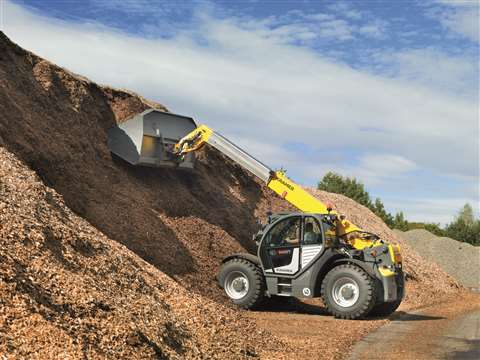
Apart from the current trend in development towards increasing intelligent design and technology to improve productivity and owner knowledge of their machines, safety features are another major part of future development trends in telehandler design, explains Mr Kelly. “Reversing aids, LSI, and rear axle stabilisation help keep the machine and operator safe, as well as those on site. Attachments like the hydraulic (dual) fork positioning carriage allow for load movement to prevent dangerous machine movement when placing loads.”
Mr Kelly views Africa and Russia as potential growth markets, while adding, “The market for telehandlers in the Middle East and Asia, in particular areas of growth such as Dubai and Abu Dhabi, has seen significant uptake in that last few years, largely coinciding with the dramatic urbanisation and economic growth in these regions. The demand is primarily for large construction machines that are durable and easy to maintain for large fleet operators.”
The company’s GC range and TH D Series TH314D and TH417D have been specifically designed to cater to this growing market, offering simple maintenance, low cost and durable machines.
“A challenge in the market is that rental rates recently have not been increasing at the same pace as the cost of machines and the new technology that is required to be competitive within the market and meet the changing demands and regulations of the rental sector,” adds Mr Kelly.
Bobcat, specialising in compact equipment, released a new generation of telehandlers in January 2017. They are equipped with Stage IV/Tier 4 Final Bobcat engines, are DPF-free and available in two power sizes: 75 and 100 HP. The 100HP engine will offer higher torque at 430 Nm for higher productivity. The 75HP engine is provided without AdBlue, but keeps its high torque at low rpm.
Bobcat has also extended its ECO mode to all models. This has already been popular on its TL models, under 10 m, as it allows lower fuel consumption, so it was decided to extend it to the over 10 m T series.
The new generation of telehandlers incorporates several new features, such as an automatic parking brake with an intuitive operation, similar to those used in the automotive industry, as well as automatic parking brake. Advanced features include an optional air dual suspension seat, an optional auto fan inversion, a rotating beacon/back-up alarm as standard and cushion retract on the three TL models. On the TL35.70, replacing the TL470, there is an improved load chart providing an additional 500 kg, bringing it up to 3500 kg at the maximum lifting height of 6.97 m.
As Quentin d’Hérouël, product manager telescopics, explains, next up will be products to meet upcoming emission laws. “The engine department has already been working for several months on the development of the new Stage V engine as the emission regulation requires a lower level of emissions from 2019.
“We are also working on more compact machines as the construction industry is always asking for more accessibility on job sites, especially in urban areas.”
Speaking of market trends Mr d’Hérouël says the overriding consideration is lowering total cost of ownership (TCO). “Especially in the rental industry. Bobcat is continuously doing its best to lower the cost of maintenance and of operation. ECO mode is an example of this, as is the DPF free engine.”
According to Mr d’Hérouël, Russia is seeing a good recovery in the telehandler market, with growth of 59% by the end of October last year.
France is also on the rise, thanks to a pick up in construction. “Housing and commercial buildings have experienced significant growth in 2016. In 2017, local authorities should also show higher investment, helping the growth.”
The potential extension of the minimum wage should also contribute to this continuous growth next year of new telehandlers at around 6%, following 14% growth last year.
He adds, “Compact telehandlers are also facing competition from other types of machines on the construction job site, such as with compact articulated loaders. For high lift telehandlers the competition is from mobile cranes or rotary telehandlers.”
Robust efficiency
Kramer-Werke concentrates on the European market with expected growth potential for Eastern Europe particularly for agricultural telehandlers.
“Our focus is on the continuation of the existing tried-and-tested series of telehandlers with lift heights of fewer than 10 m, as we successfully cover the main market segment in Europe with this model range,” says Andreas Breunig, head of product management.
The company introduced new telehandlers at Bauma 2016: the models in the 6 m to 9 m class were equipped with stage IV engines, as well as with some new options. Its compact 2706 model was designed as the successor to the 2506. A new engine of the exhaust emission stage IIIB, an increased payload and numerous features are designed to make the telehandler an real all-rounder in the compact class.
“All of our models combine the robustness and efficiency output of a wheel loader with the versatility and flexibility of a telehandler,” says Mr Breunig.
An additional customer benefit results from the intelligent operator assistance system Smart Handling.
With three operating modes it allows for safe work in any load situation without the machine entering into the critical overload range, and at the same time increases the efficiency of the work processes through partially automated movement sequences of the loader unit.
Skyjack is presenting its new SJ1256 TH telehandler during ConExpo in Las Vegas, in March. The model brings the TH range, aimed at the North American market, to the 12000 pound lifting capacity market. In 2016, Skyjack completely reassessed its telehandler design while implementing the Tier IV Final engines, resulting in the TH range which offers simpler rear axle stabilisation, hydraulics systems, outriggers, controls, engine servicing and electronics. The company is making a serious impact on the telehandler sector, where it has had a small market share in previous times. The SJ1256 TH has the ability to place 12000 pound loads to 35 ft in height and 7000 pounds to a maximum height of 56 ft. For another new product, the SJ1056 TH, Skyjack aimed to redefine what a 10000 pound class machine is capable of. The SJ1056 TH can take 10000 pounds load to 44 ft – providing increased productivity and versatility over most 12000 pound units, the company says.Full line Also, when it comes to Tier IV Final regulations, “Skyjack knew rental rates don’t just go up to meet the increased costs of emissions compliance,” says Barry Greenaway, senior product manager, Skyjack. That’s why the company designed the TH range to require no diesel particulate filter (DPF), while the SJ643 TH up to the SJ1056 TH require no diesel exhaust fluid (DEF) and no other active exhaust after treatment on standard engines for Tier IV Final.As of this time, the SJ1256 TH is the only unit with a 2017 release date. But Skyjack is now investigating designs for other category classes as part of its commitment to being a full line supplier. “We believe the trend is towards telehandlers truly designed with the rental marketplace in mind,” comments Mr Greenaway. “The demands of that market typically have variations from the end user market and our interpretation of how best to meet them is with simple, reliable designs that have priorities on uptime, service access and that use affordable, easy to source parts. We also see features, like our FlexCab that can be easily be converted from open to enclosed for example, that assist fleet managers from both small and large rental companies.”And, as the number of telehandlers on the market becomes ever larger, customers experience increased pressure on rental rates to retain their accounts. “Helping our customers with that success requires more than just a focus on initial acquisition cost; continuous improvement to reduce running costs and increase product flexibility is a constant challenge.”It won’t have escaped many people’s notice that while Skyjack has been actively making inroads into the telehandler market, JCB –already a major telehandler manufacturer - has entered the access equipment market. Not just with a range of platform options launched in 2016 for its 540-140, 540-170 and 540-200 models, along with the 540-180 launched this year, but with a range of 27 scissors and booms promised throughout this year. (See Manufacturer News in the January/February issue of AI for more details on this).This year, the company has also been busy launching new telehandler products. The JCB 540-180 is an 18 m lift height, HiViz model which has gone into production this year. The 540-180 HiViz offers greater performance and lifting capability than its 17 m stablemate the 540-170 – despite being 20% smaller in overall dimensions. Its launch brings to 82 the number of Loadall models in the JCB range.The 540-180 HiViz has been specifically built to meet the needs of rental companies with improved lift height and increased forward reach. At just 2.35m wide and 6.26m long it is possible to move two machines on a single curtain sided truck or low loader, reducing transport costs. Dual technologyThis year has also seen the development of what JCB describes as the world’s first dual technology transmission designed specifically for its Loadall telehandlers. Combining the characteristics of powershift and hydrostatic drives, the Industrial DualTech VT variable transmission includes fully hydrostatic drive, providing fine stepless speed control up to 19km/h, automatic switching to electronically-modulated three-speed powershift above 19km/h, for optimum power efficiency in higher speed work, plus Power and Economy modes to optimise performance, efficiency and running costs. Flexi mode provides independent engine and ground speed control. This innovation has now been introduced with the 531-70 Industrial DualTech VT, 535-95 Industrial DualTech VT and 541-70 Industrial DualTech VT models. A range of high capacity, industrial telescopic handlers also joined the range in September 2016.In addition Smart power, which sees JCB Loadalls achieve relevant emissions legislation without the need for exhaust after treatment, is now a feature across the JCB telehandler line-up.A key requirement from the industry, says the company, and a focus for JCB has been to improve the direct visibility for the operator. This reduces the potential for accidents on site and the potential for site damage to the machines themselves.However, the company says it did not see substantial growth in 2016. “It has actually declined slightly. JCB expects 2017 to see a return to growth in the EU and North America. The developing markets represent the biggest growth potential for telescopic handlers,” said a company spokesperson. Oil prices and agricultural commodity prices are likely to be the biggest influences on growth.Cat is also launching new products. In 2017, the company will introduce further models for construction and rental in the TH D Series. This new series has been developed to improve efficiency, power, and to help make servicing and maintenance easier. The 4000 kg capacity TH314D and TH417D will replace the current GC Series and are specifically designed for the rental market. The TH514D also replaces the TH514C. In addition, for North and South America, the TL D Series range was released in 2016, as was the TH3510D, announced in April. It provides 9.8 m lift height and 3500 kg lift capacity, within a compact frame for space restricted sites. This all adds to Cat’s existing TH C Series, featuring two 14 m telehandlers with 4000 kg and 5000 kg lift capacities, and a 4000 kg capacity, 17 m telehandler for construction markets. In North and South America, the company also offers four high boom models in the TL Series: TL642D, TL943D, TL1055D, and TL1255D.Matthew Kelly, telehandler marketing specialist for Cat explains, “The main feature are improved cycle times and lift capacity of our machines due to flow sharing technology.” The longitudinally mounted engine allows ground level access to filters and maintenance parts. And new on the D models, is the advanced display monitor that provides information on maintenance schedules, diagnostics, and machine settings. The low boom-pivot point and elevated cab ensure good visibility, while increased safety comes from a new reversing camera and reversing peripheral sensor.The manufacturer’s Product Link system wirelessly connects owners to their equipment, providing access to machine data such as location, hours, fuel consumption, idle time, events, and diagnostic codes for analysis and reporting via the online VisionLink user interface. Safety features Apart from the current trend in development towards increasing intelligent design and technology to improve productivity and owner knowledge of their machines, safety features are another major part of future development trends in telehandler design, explains Mr Kelly. “Reversing aids, LSI, and rear axle stabilisation help keep the machine and operator safe, as well as those on site. Attachments like the hydraulic (dual) fork positioning carriage allow for load movement to prevent dangerous machine movement when placing loads.” Mr Kelly views Africa and Russia as potential growth markets, while adding, “The market for telehandlers in the Middle East and Asia, in particular areas of growth such as Dubai and Abu Dhabi, has seen significant uptake in that last few years, largely coinciding with the dramatic urbanisation and economic growth in these regions. The demand is primarily for large construction machines that are durable and easy to maintain for large fleet operators.” The company’s GC range and TH D Series TH314D and TH417D have been specifically designed to cater to this growing market, offering simple maintenance, low cost and durable machines. “A challenge in the market is that rental rates recently have not been increasing at the same pace as the cost of machines and the new technology that is required to be competitive within the market and meet the changing demands and regulations of the rental sector,” adds Mr Kelly. Bobcat, specialising in compact equipment, released a new generation of telehandlers in January 2017. They are equipped with Stage IV/Tier 4 Final Bobcat engines, are DPF-free and available in two power sizes: 75 and 100 HP. The 100HP engine will offer higher torque at 430 Nm for higher productivity. The 75HP engine is provided without AdBlue, but keeps its high torque at low rpm.Bobcat has also extended its ECO mode to all models. This has already been popular on its TL models, under 10 m, as it allows lower fuel consumption, so it was decided to extend it to the over 10 m T series.The new generation of telehandlers incorporates several new features, such as an automatic parking brake with an intuitive operation, similar to those used in the automotive industry, as well as automatic parking brake. Advanced features include an optional air dual suspension seat, an optional auto fan inversion, a rotating beacon/back-up alarm as standard and cushion retract on the three TL models. On the TL35.70, replacing the TL470, there is an improved load chart providing an additional 500 kg, bringing it up to 3500 kg at the maximum lifting height of 6.97 m.As Quentin d’Hérouël, product manager telescopics, explains, next up will be products to meet upcoming emission laws. “The engine department has already been working for several months on the development of the new Stage V engine as the emission regulation requires a lower level of emissions from 2019. “We are also working on more compact machines as the construction industry is always asking for more accessibility on job sites, especially in urban areas.” Speaking of market trends Mr d’Hérouël says the overriding consideration is lowering total cost of ownership (TCO). “Especially in the rental industry. Bobcat is continuously doing its best to lower the cost of maintenance and of operation. ECO mode is an example of this, as is the DPF free engine.”According to Mr d’Hérouël, Russia is seeing a good recovery in the telehandler market, with growth of 59% by the end of October last year. France is also on the rise, thanks to a pick up in construction. “Housing and commercial buildings have experienced significant growth in 2016. In 2017, local authorities should also show higher investment, helping the growth.” The potential extension of the minimum wage should also contribute to this continuous growth next year of new telehandlers at around 6%, following 14% growth last year. He adds, “Compact telehandlers are also facing competition from other types of machines on the construction job site, such as with compact articulated loaders. For high lift telehandlers the competition is from mobile cranes or rotary telehandlers.”Robust efficiencyKramer-Werke concentrates on the European market with expected growth potential for Eastern Europe particularly for agricultural telehandlers. “Our focus is on the continuation of the existing tried-and-tested series of telehandlers with lift heights of fewer than 10 m, as we successfully cover the main market segment in Europe with this model range,” says Andreas Breunig, head of product management. The company introduced new telehandlers at Bauma 2016: the models in the 6 m to 9 m class were equipped with stage IV engines, as well as with some new options. Its compact 2706 model was designed as the successor to the 2506. A new engine of the exhaust emission stage IIIB, an increased payload and numerous features are designed to make the telehandler an real all-rounder in the compact class. “All of our models combine the robustness and efficiency output of a wheel loader with the versatility and flexibility of a telehandler,” says Mr Breunig.An additional customer benefit results from the intelligent operator assistance system Smart Handling. With three operating modes it allows for safe work in any load situation without the machine entering into the critical overload range, and at the same time increases the efficiency of the work processes through partially automated movement sequences of the loader unit.






